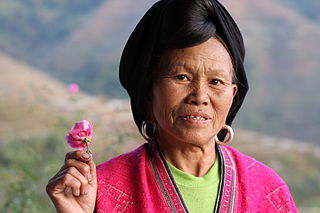Further reading
- Jiang Jun [蒋俊]. 2005. Ethnic group and nation in the village vision: Field research about Lai people [村落视野中的族群与民族:关于俫人的田野研究]. M.A. dissertation, Guangxi Normal University. http://www.docin.com/p-380721709.html
| Total population | |
|---|---|
| >2,400 | |
| Regions with significant populations | |
| China (Longlin County, Guangxi and Yunnan) | |
| Languages | |
| Bolyu (frequently not) | |
| Religion | |
| Traditional |
Bolyu is one of the unrecognized ethnic groups in China. Bolyu language (autonym: pɔ˧lju˩˧; Chinese :巴琉语, 布流语; also known as Paliu, Palyu, or Lai 俫语, 徕语) is an Austroasiatic language of the Pakanic branch (Sidwell 1995). It is unwritten and moribund.

The She people are an ethnic group in China. They form one of the 56 ethnic groups officially recognized by the People's Republic of China.

The Yao people is a government classification for various minorities in China and Vietnam. They are one of the 55 officially recognised ethnic minorities in China and reside in the mountainous terrain of the southwest and south. They also form one of the 54 ethnic groups officially recognised by Vietnam. In China in the last census in 2000, they numbered 2,637,421 and in Vietnam census in 2019, they numbered 891,151.

Wenshan Zhuang and Miao Autonomous Prefecture is an autonomous prefecture in southeastern Yunnan Province, People's Republic of China and the easternmost prefecture-level division of the province. It borders Baise, Guangxi to the east, Vietnam's Hà Giang Province to the south for 438 kilometres (272 mi), Honghe Hani and Yi Autonomous Prefecture to the west and Qujing to the north.
The Pakanic languages constitute a branch of two Austroasiatic languages, Bolyu and Bugan. They are spoken in Guangxi and Yunnan provinces of southern China. Mang was formerly included, but is now considered by Paul Sidwell to form its own separate branch within Austroasiatic.

Longlin Various Nationalities (Gezu) Autonomous County is an autonomous county, under the jurisdiction of the prefecture-level city of Baise, in the west of Guangxi, China, bordering Guizhou Province to the north. As of 2019, the county's population was 437,907 people.
Bu-Nao, or Bunu proper, is a Hmongic (Miao) dialect cluster spoken in Guangxi, Yunnan, and Guizhou in China. Its speakers are among the Bunu : ethnic Yao (Mien) speakers of Miao languages.
The Bolyu language is an Austroasiatic language of the Pakanic branch. The Bolyu are among the unrecognized ethnic groups of China.
Li Jinfang is a Chinese linguist at Minzu University in Beijing, China. Li, an ethnic Zhuang, is a leading specialist in the Kra-Dai languages of southern China, especially the Kra (Geyang) branch. Li's doctoral dissertation focused on the Buyang language, and was published as Studies on the Buyang Language in 1999.

Gyalrong or rGyalrong, also rendered Jiarong, or sometimes Gyarung, is a subbranch of the Gyalrongic languages spoken by the Gyalrong people in Western Sichuan, China. Lai et al. (2020) refer to this group of languages as East Gyalrongic.
Nasu, or Nasu proper, is a Loloish language spoken by a quarter million Yi people of China. Nasu proper and Wusa Nasu are two of six Yi languages recognized by the government of China. Unlike most written Yi languages, Nasu proper uses the Pollard (Miao) script. A distinct form of the Yi script was traditionally used for Wusa, though few can still read it.
Luobohe Miao, also known as Hmjo or A-Hmyo, is a Miao language of China.
Caijia is an endangered Sino-Tibetan language spoken in an area centred on Bijie, in the west of the Chinese province of Guizhou. It was first documented by Chinese researchers in the 1980s. It has been described by different authors as a relative of Bai or an early split from Old Chinese. The autonym is.
The Hani languages are a group of closely related but distinct languages of the Loloish (Yi) branch of the Tibeto-Burman linguistic group. They are also referred to as the Hanoid languages by Lama (2012) and as the Akoid languages by Bradley (2007).
The Greater Bai or simply Bai languages are a putative group of Sino-Tibetan languages proposed by Zhengzhang, a linguist, in 2010, who argues that Bai and Caijia are sister languages. In contrast, Sagart (2011) argues that Caijia and the Waxiang language of northwestern Hunan constitute an early split off from Old Chinese. Additionally, Longjia and Luren are two extinct languages of western Guizhou closely related to Caijia.
Longjia is a Sino-Tibetan language of Guizhou, China related to Caijia and Luren. Longjia may already be extinct.
Lu, or Luren (卢人), is an extinct Sino-Tibetan language of Guizhou, China. The Luren language may have been extinct since the 1960s.
Nuoxi Yao, or Nuoxihua 𦰡溪话, is a Kam–Sui language of Nuoxi Township, Dongkou County, Hunan Province, China. Even though they are classified as ethnic Yao people by the Chinese government, the Nuoxi Yao speak a Kam–Sui language closely related to Dong. Shi (2015:132) considers Nuoxi Yao to have split off from Dong about 600 years.
Baihong is a Southern Loloish language of Yunnan, China. It is spoken in Jiangcheng Hani and Yi Autonomous County, Mojiang Hani Autonomous County, Yuanjiang Hani, Yi and Dai Autonomous County, Lüchun County, and Yuanyang County, Yunnan.
Shehua is an unclassified Sinitic language spoken by the She people of Southeastern China. It is also called Shanha, San-hak (山哈) or Shanhahua (山哈话). Shehua speakers are located mainly in Fujian and Zhejiang provinces of Southeastern China, with smaller numbers of speakers in a few locations of Jiangxi, Guangdong and Anhui provinces.
The Ili Turks are a Turkic unrecognized ethnic group in China native to Ili Kazakh Autonomous Prefecture in Northern Xinjiang of China, and Kazakhstan. They call themselves "Turk" or "Zhonghua Minzu". Their oral history says they came from the Ferghana Valley, Uzbekistan. The distinct Ili Turki language belongs to the Karluk languages, but is listed as Uzbek by Chinese authorities.